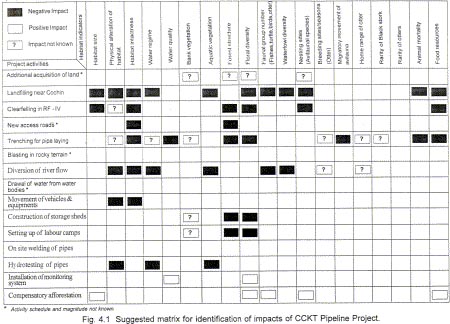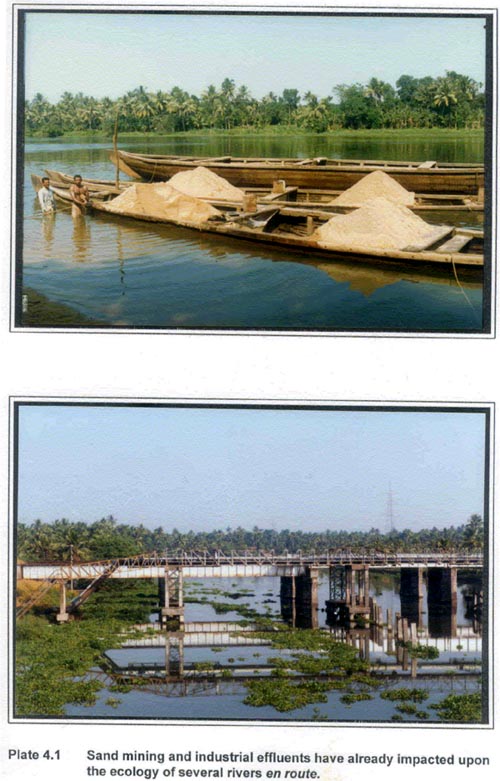Impact Prediction
|
The most important step in EIA is the impact prediction. The process of EIA revolves around the identification of cause and effect, a cause being any action of the proposed project which has an effect on the environment. The success of an environmental impact assessment depends on the ability to perceive environmental changes and predict the future impacts that could be related to the proposed development. The soundness of the predictive ability is governed to a large extent by professional judgement, past experiences of related projects and some basic assumptions. The basis for impact identification is provided by the baseline information pertaining to the project environment that has been generated through select biological attributes (vegetation, wildlife habitats, wildlife species), determined by the scope of the EIA study. This section of the report focuses on the implications of project related actions on the environment which, for the purpose of this study, would remain confined to wetlands and forests within the proposed pipeline corridor of CCKT Project. As is obvious from the nature of changes that are anticipated in the biological environment, past and current ecological trends provide a useful means to derive inferences for prediction of impacts. Evaluation of project impacts involve linking of project actions to the probable changes that these impacts would induce in the biological environment by the likely alteration in the ecological trends. The logical linking of actions and changes demand substantial information of the sequence of events that are likely to occur, if the proposed development is implemented. The choice of variables that can serve as environmental indicators is also crucial to project an overview of project induced environmental changes. The anticipated major activities under CCKT Pipeline Project, that are expected to bring about alterations in the biological environment, are as follows:
The key indicators of habitat quality, faunal and floral species diversity and status of wildlife values are selected from an exhaustive list appended as Annexure - III. The overall impacts of CCKT Project are projected in the matrix (Fig. 4.1) that has been developed on the similar pattern as those developed by Leopold et. al. (1971) and modified for projecting impacts of pipeline projects (Rajvanshi, 1995).
It became imperative to consider some significance factors that would allow an assessment of conservation value of impacted habitats and species. Fragility of ecosystems, restoration potential and conservation status are being considered to be adequate criteria for determining the conservation significance of wildlife habitats en route the proposed CCKT Pipeline route. The significance and magnitude or scale of ecological impacts has been well understood prior, recognising the critical constraints that can influence the decisions on the implementation of the proposed project. Specific impacts on habitat categories, identified earlier for the purpose of this study, are given as under: 4.1 WETLANDS 1. Habitat for migrating (diurnal, nocturnal, seasonal) terrestrial and aquatic animals. 2. Nesting and reproductive habitat for aquatic and terrestrial biota. 3. Food source for indigenous and migratory animals. 4. Critical habitats for rare and endangered or other protected species. The environmental impact assessment must therefore, consider the impacts that would affect the ecological functions of wetlands. The proposed study has identified some major impacts on different categories of wetlands within the CCKT Pipeline corridor. 4.1.1 Rivers
Table 4.1 summarizes the different kinds of biotic disturbances influencing the riverine habitat quality. Table 4.1 Biotic disturbance operating in the rivers en route the pipeline.
Of the different rivers en route the pipeline, three rivers Kaniyampuzha, Periyar and Chalakudi have reported distribution of all the three species of otters characteristic of Indian subcontinent. These are, Smooth coated otter (Lutra perspicillata), Common otter (Lutra lutra) and Oriental small clawed otter (Aonyx cinerea). All these three aquatic mammalian species have great conservation significance on account of their highly endangered status. Their inclusion under Schedule - I and II of the Indian Wildlife (Protection) Act, (1972), places greater emphasis on promotion of conservation efforts to protect all potential habitats of these species even outside the protected area network of the country. The execution of CCKT Pipeline Project is likely to create some disturbances on the rivers and their banks and thereby on the otter ecology. It is understandable that the laying of the pipeline on the river is a phased activity that would lead to temporary changes in the river flow. These changes are likely to result in temporary abandonment of the habitat by the otters in the specific stretches of rivers affected by the project activity. Abandonment of habitats resulting from disturbances associated with CCKT Pipeline can also lead to alterations in the otter home range. Studies conducted on otters in captivity and those in wild confirm that the period between August to February corresponds to the breeding season of otters (Desai, 1974; Hussain, 1993). The coincidence of construction related activities across the rivers, with the breeding period of otters in those areas, can lead to changes in the population ecology. None of these rivers support any turtle and avifaunal species of threatened status. Moreover, the large scale commercial exploitation of turtles from these rivers has already resulted in their depleted status (Choudhury and Bhupathy, 1993). No significant impacts are therefore anticipated on turtles. 4.1.2 Reservoir Perennou et. al, (1994) has expressed concern over the declining population of Black bellied tern (Sterna acuticauda). The Bar headed goose (Anser indicus) also reported from Walayar reservoir is another threatened species. The threats to this bird are poaching, egg collection, predation and loss of breeding habitats (WWF, 1993). Both these species have been recommended for listing under globally threatened species. Considering the conservation significance of Walayar reservoir on account of it being a critical habitat for rare and threatened species, the impacts of CCKT Pipeline Project of even smaller magnitude and shorter duration are likely to be a threat to this wetland ecosystem. 4.1.3 Marshes 4.2 FORESTS |
|||||||||||||||||||||||||||||||||||||||||||
Last Updated: October 7, 2015











